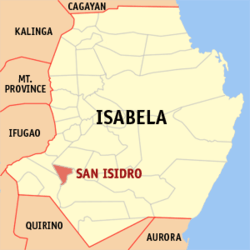San Isidro, Isabela
San Isidro, officially the Municipality of San Isidro (Ilocano: Ili ti San Isidro; Tagalog: Bayan ng San Isidro), is a 5th class municipality in the province of Isabela, Philippines. According to the 2015 census, it has a population of 24,861 people.[3]
San Isidro | |
|---|---|
| Municipality of San Isidro | |
 Seal | |
 Map of Isabela with San Isidro highlighted | |
OpenStreetMap 
| |
.svg.png) San Isidro Location within the Philippines | |
| Coordinates: 16°52′N 121°46′E | |
| Country | |
| Region | Cagayan Valley (Region II) |
| Province | Isabela |
| District | 6th District of Isabela |
| Founded | 1967 |
| Barangays | 13 (see Barangays) |
| Government | |
| • Type | Sangguniang Bayan |
| • Mayor | Vilmer B. Bravo |
| • Vice Mayor | Leticia M. Cruz |
| • Congressman | Faustino Michael T. Dy III |
| • Electorate | 15,506 voters (2019) |
| Area | |
| • Total | 71.90 km2 (27.76 sq mi) |
| Population (2015 census)[3] | |
| • Total | 24,861 |
| • Density | 350/km2 (900/sq mi) |
| • Households | 5,545 |
| Economy | |
| • Income class | 5th municipal income class |
| • Poverty incidence | 11.71% (2015)[4] |
| • Revenue (₱) | 67,811,751.71 (2016) |
| Time zone | UTC+8 (PST) |
| ZIP code | 3310 |
| PSGC | |
| IDD : area code | +63 (0)78 |
| Climate type | tropical rainforest climate |
| Native languages | Ilocano Tagalog |
| Website | www |
Barangays
San Isidro is politically subdivided into 13 barangays. [2]
- Camarag
- Cebu
- Doña Paulina
- Gomez (Poblacion)
- Gud
- Nagbukel
- Patanad
- Quezon
- Ramos East
- Ramos West
- Rizal East
- Rizal West
- Villaflor
Demographics
| Year | Pop. | ±% p.a. |
|---|---|---|
| 1970 | 8,384 | — |
| 1975 | 9,737 | +3.05% |
| 1980 | 11,527 | +3.43% |
| 1990 | 14,444 | +2.28% |
| 1995 | 16,043 | +1.99% |
| 2000 | 18,603 | +3.22% |
| 2007 | 21,387 | +1.94% |
| 2015 | 24,861 | +1.90% |
| Source: Philippine Statistics Authority[3][5][6][7] | ||
In the 2015 census, the population of San Isidro, Isabela, was 24,861 people,[3] with a density of 350 inhabitants per square kilometre or 910 inhabitants per square mile.
Climate
| Climate data for San Isidro, Isabela | |||||||||||||
|---|---|---|---|---|---|---|---|---|---|---|---|---|---|
| Month | Jan | Feb | Mar | Apr | May | Jun | Jul | Aug | Sep | Oct | Nov | Dec | Year |
| Average high °C (°F) | 29 (84) |
30 (86) |
32 (90) |
35 (95) |
35 (95) |
35 (95) |
34 (93) |
33 (91) |
32 (90) |
31 (88) |
30 (86) |
28 (82) |
32 (90) |
| Average low °C (°F) | 19 (66) |
20 (68) |
21 (70) |
23 (73) |
23 (73) |
24 (75) |
23 (73) |
23 (73) |
23 (73) |
22 (72) |
21 (70) |
20 (68) |
22 (71) |
| Average precipitation mm (inches) | 31.2 (1.23) |
23 (0.9) |
27.7 (1.09) |
28.1 (1.11) |
113.5 (4.47) |
141.4 (5.57) |
176.4 (6.94) |
236.6 (9.31) |
224.9 (8.85) |
247.7 (9.75) |
222.9 (8.78) |
178 (7.0) |
1,651.4 (65) |
| Average rainy days | 10 | 6 | 5 | 5 | 13 | 12 | 15 | 15 | 15 | 17 | 16 | 15 | 144 |
| Source: World Weather Online[8] | |||||||||||||
gollark: I'd argue that I'm actually best, due to LyricLy literally Macaron.
gollark: Technically, joint worst.
gollark: Maybe your metric is wrong.
gollark: As they say, something something low sample size.
gollark: I can use a face editor.
References
- "Municipality". Quezon City, Philippines: Department of the Interior and Local Government. Retrieved 31 May 2013.
- "Province: Isabela". PSGC Interactive. Quezon City, Philippines: Philippine Statistics Authority. Retrieved 12 November 2016.
- Census of Population (2015). "Region II (Cagayan Valley)". Total Population by Province, City, Municipality and Barangay. PSA. Retrieved 20 June 2016.
- "PSA releases the 2015 Municipal and City Level Poverty Estimates". Quezon City, Philippines. Retrieved 1 January 2020.
- Census of Population and Housing (2010). "Region II (Cagayan Valley)". Total Population by Province, City, Municipality and Barangay. NSO. Retrieved 29 June 2016.
- Censuses of Population (1903–2007). "Region II (Cagayan Valley)". Table 1. Population Enumerated in Various Censuses by Province/Highly Urbanized City: 1903 to 2007. NSO.
- "Province of Isabela". Municipality Population Data. Local Water Utilities Administration Research Division. Retrieved 17 December 2016.
- "San Isidro, Isabela: Average Temperatures and Rainfall". World Weather Online. Retrieved 3 November 2015.
External links
- San Isidro Profile at PhilAtlas.com
- Municipal Profile at the National Competitiveness Council of the Philippines
- San Isidro at the Isabela Government Website
- Local Governance Performance Management System
- Philippine Standard Geographic Code
- Philippine Census Information
- Official website
This article is issued from Wikipedia. The text is licensed under Creative Commons - Attribution - Sharealike. Additional terms may apply for the media files.